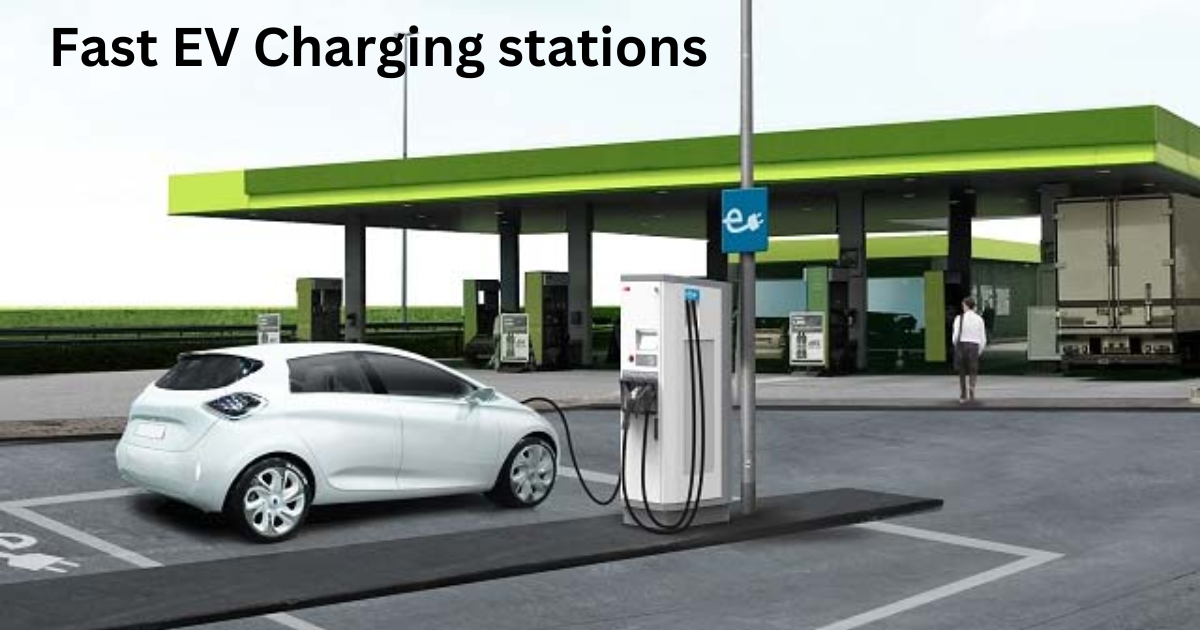In this Blog teamautoexpert explains the idea of fast EV charging stations 2023 Revolutionizing the EV Industry, their advantages, disadvantages, and the revolutionary changes they are bringing about in the electric vehicle sector. Electric vehicles (EVs) have become a key component in the fight against the damaging environmental effects of conventional internal combustion engine automobiles. The importance of Fast EV charging stations has grown as the entire world works to cut carbon emissions and switch to sustainable transportation. By addressing one of the main concerns of prospective EV owners, charging time, fast charging stations play a crucial role in promoting the mainstream adoption of EVs. Teamautoexpert explains the idea of fast EV charging stations, their advantages, disadvantages, and the revolutionary changes they are bringing about in the electric vehicle sector.

Fast EV Charging Stations: 2023 Revolutionizing the EV Industry
Understanding Fast EV Charging Stations:
Electric vehicles can charge much more quickly using fast EV charging stations than they can with regular charging stations since they can transfer a lot more electricity to them. Three different types of EV charging stations are available:
- Level 1 Charging: This is the slowest form of charging and typically involves plugging the EV into a standard household electrical outlet. It provides a charging rate of around 2 to 5 miles of range per hour, making it suitable for overnight charging.
- Level 2 Charging: Level 2 charging involves higher-power charging stations, often found in public places and residential installations. These charging stations offer a charging rate of approximately 10 to 30 miles of range per hour, significantly faster than Level 1.
- DC Fast Charging: Also known as Level 3 charging, DC fast chargers are the fastest charging stations available to the public. They utilize direct current (DC) to rapidly charge the EV’s battery. DC fast chargers can provide around 60 to 80 miles of range in just 20 minutes, making them ideal for quick top-ups during long journeys.

Stay tuned with teamautoexpert for more updates and for the latest auto news and reviews.
Advantages of Fast EV Charging Stations:

- Reduced Charging Time: Fast EV charging stations drastically reduce charging time, making EV ownership more practical and convenient for daily commuters and long-distance travelers alike. With faster charging speeds, the anxiety associated with waiting for the vehicle to charge is significantly minimized.
- Enabling Long-Distance Travel: One of the most significant barriers to EV adoption has been “range anxiety” – the fear of running out of battery power during long trips. Fast charging stations strategically placed along highways and major routes empower EV drivers to embark on long-distance journeys with confidence.
- Supporting Urban Infrastructure: In densely populated areas and cities, the availability of fast EV charging stations is crucial for accommodating a larger number of electric vehicles without causing charging bottlenecks.
- Economic Incentives: The rise of fast EV charging stations has led to the emergence of charging infrastructure businesses. This has not only created job opportunities but has also bolstered the EV industry’s overall growth.
Technology’s Problems and Answers :
Although quick EV charging stations have several advantages, they face a number of technological obstacles that must be overcome:
- Power Grid Restrictions: Because fast charging stations use a lot of power, their broad adoption may put a strain on the current power grid. Smart charging solutions and grid upgrades can assist manage the load and optimise power distribution.
- Considering the Battery: Rapid charging at high power levels might produce heat and perhaps shorten the life of the battery. To address these issues, researchers are looking into battery advances, thermal management technologies, and improved battery chemistry.
- Standardisation and compatibility: It’s crucial to standardise fast charging connectors and protocols among different EV models in order to guarantee a seamless user experience and interoperability.
Environmental Impact:
Fast EV charging stations play a crucial role in reducing carbon emissions:
1. Reduced Fossil Fuel Dependency: We can reduce our dependency on fossil fuels and thereby reduce greenhouse gas emissions by encouraging the adoption of EVs through quick charging infrastructure.
2.Integration with Renewable Energy: Combining rapid charging stations with environmentally friendly energy sources like solar and wind power can increase their environmental advantages and create a cleaner, more sustainable mobility ecosystem.
Current State and Future Trends:
Major players have been investing in charging infrastructure, which has led to a steady rise in the deployment of rapid EV charging stations worldwide:
1.Global Adoption: Developing nations all over the world are investing in fast charging infrastructure with the goal of promoting the use of electric vehicles (EVs).
2.Major Players: Traditional energy providers and businesses that specialise in EV charging solutions are both investing heavily in the creation of rapid charging stations.
3.Government Grants and Incentives: Many governments provide grants and incentives to hasten the implementation of quick EV charging infrastructure.
The development of ultra-fast charging technologies, which promise even faster charging times, is a constant goal of researchers and manufacturers.
Challenges to Overcome:
Several challenges exist that must be addressed to maximize the benefits of fast EV charging stations:
1.Cost factors: Establishing rapid charging infrastructure can be costly, therefore finding affordable solutions is crucial for further adoption.
2.Land Use and Infrastructure: Urban planners must carefully plan the physical space needed for rapid charging stations and incorporate charging infrastructure into their plans.
3.Public Awareness and Education: To dispel myths and encourage EV adoption, it is essential to educate the public about the advantages of EVs and quick charging.
Initiatives and Success Stories:
Various initiatives and projects are driving the expansion of fast EV charging stations:
- Collaborations: Partnerships between governments, private companies, and non-profit organizations are fostering the development of charging infrastructure.
- Successful Implementations: Case studies of cities or regions that have successfully implemented fast charging networks and experienced increased EV adoption.
Conclusion:
Fast EV charging facilities are essential for advancing sustainable transportation. They increase the practicality, convenience, and accessibility of electric vehicles for a larger audience by sharply reducing charging times. However, technological, economic, and policy issues need to be resolved via innovation, teamwork, and public support if rapid charging infrastructure is to reach its full potential. We can get closer to a cleaner and greener transport scene for future generations by embracing this breakthrough technology.